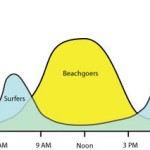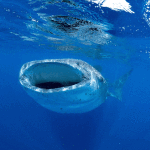The ends of Permian and Triassic periods were a very bad time for marine invertebrates. Suffering, starvations, watching loved ones die…very hard times indeed. A whole spectrum of hypotheses is out there to account for mass extinctions including giant asteroid impacts, major shifts in oceanographic conditions, and various climatic changes. A new paper by Powers and Bottjer in Geology examining an unusual animal group may shed some light on what occurred. The authors collect data on Bryozoans, a group still occurring today with 5,000 species, of the early Permian to the Late Triassic. Bryozoans, referred to some unenlightened few as ‘moss animals’ are colonial organisms comprised of multiple zooids that often can form substantial mats.. They are grouped with Brachiopods (the non-molluscan lamp shells) and Phoronids (a worm-like group) based on the presence of a lophophore, a tentacled organ, developmentally derived from the body wall, that surrounds the mouth. Interestingly, the group is neither a protostome nor a deuterostome.
Powers and Bottjer find that for these extinctions the number of species of bryozoans declined in the deep sea first. The authors suggesting that thus the degradation of oceanographic conditions in deep water, as opposed to a bolide impact which is hypothesized to affect shallow-water environments first, triggered these mass die-offs of marine fauna. The most likely scenario is a deep-water anoxic, low oxygen, events that eventually migrated into shallower waters.

Figure 1 from Powers & Bottjer (2007). Contoured Permian-Early Jurassic time-environment (T-E) diagram of marine bryozoans. Each dot represents a data point,
either for assemblage with the greatest bryozoan generic richness in each T-E bin, or for absence of bryozoans validated by the taphonomic control group. Horizontal axis represents environmental zones; vertical axis represents time in millions of years (Gradstein and Ogg, 2004). Stratigraphic and locality information and references are in Table DR2 (see footnote 1). Early Permian: A–Asselian, S–Sakmarian, Ar–Artinskian, K–Kungurian. Middle Permian (MP): R–Roadian, W–Wordian, C-Capitanian. Late Permian (LP): W–Wuchiapingian, C–Changsingian. Early Triassic (ET): *–Induan , O–Olenekian. Middle Triassic: A–Anisian, L–Ladinian. Late Triassic: C–Carnian, N–Norian, R–Rhaetian. Early Jurassic: H–Hettangian, S–Sinemurian, P–Pliensbachian, T–Toarcian. Bryozoan assemblages are composed of the following stenolaemate orders: Permian Fenestrida; Permian-Triassic Trepostomida, Cryptostomida, and Cystoporida; and Permian-Jurassic Cyclostomida. Contouring was done separately for each time period using cubic interpolation. Four phases of bryozoan paleoenvironmental history include: A, wide distribution across all environments from Early into Middle Permian, followed by middle-Late Permian decline in offshore settings; B, patchy distribution during Early Triassic; C, gradual recolonization of marine environments during Middle-early-Late Triassic but restriction to middle shelf and reefal settings in latest
Triassic; and D, restriction to shelf settings during Early Jurassic.






thanks for the heads up on this citation…. who knew bryozoans would become players in sexy extinction science? i may be mistaken, but i don’t think a bolide was ever a leading contender as catalyst for the permian die-off… all the smoking gun hypotheses i recall (from scenarios envisioned by jack sepkoski to more recent speculation by michael benton) pointed to more home-grown catastrophic events involving chemistry…
while i think a lot of writers point to events like the permian biodiversity bottleneck as “exceptions” to geologic uniformitarianism, i think it’s a fitting example of the big picture of tempo and mode in the history of life… and if life can rebound from this catastrophe, it also gives me hope with the damage we’re currently exacting on species on land and in sea…
Ditto on the bolide hypothesis. I can think of two pieces of literature with that viewpoint which fall into the category of “highly cited but thoroughly discredited inside the field”. If they bother to mention it they’re just piling on.
That said, ocean anoxia is pretty well established at the boundary and understanding how it developed is an exciting subject.